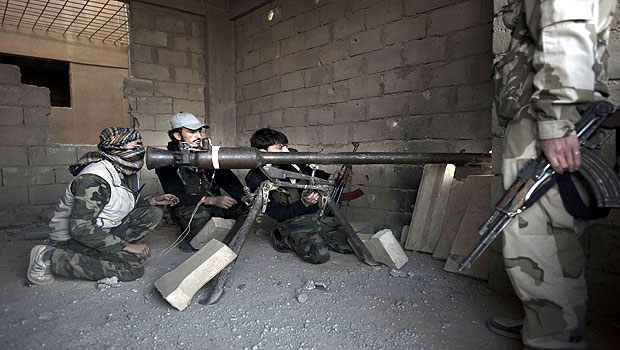
Rebels fighters prepare to fire a recoilless rifle against an adjacent Syrian government-held building during fighting in the Hawiqah neighbourhood of the eastern Syrian town of Deir Ezzor.(AFP)
Eliot Higgins, who maintains the ‘Brown Moses’ blog, has garnered the attention and interest of reporters and news outlets from across the world. By using the evidence of video footage of the fighting in Syria posted by journalists, and also by the combatants themselves, he has traced the evolution of the rebels’ arsenal, allowing the global media to build up a more accurate picture of the fighting.
Writing on the New York Times ‘At War’ blog, he discussed his work in ways that demonstrates the growing impact of social media networks and the influence of those attuned to them: “With hundreds of videos showing the activities of fighting groups now posted on YouTube each day, external analysts have been allowed to build a picture of events in Syria that in past wars have gone unrecorded.”
With many mobile phones now also digital video cameras, the torrent of images and footage from conflict zones where the fighting takes place among the populace has become a flood. By sifting through the footage, bloggers like Higgins are able to tease out some of the patterns that might escape the casual observer, in the same way that was once the preserve of military intelligence analysts.
In an email to Asharq Al-Awsat, he explained his motivations for starting his blog: “I’ve always had an interest in politics and current events, so when the Arab Spring started I began to follow it very closely. One thing that really stood out was the role social media was playing, and how information from social media was being presented by various sources and debated and dissected online. I started the blog out of my own desire to make some sense of the information being providing through social media, especially as frequently I saw aspects of the conflict that wasn’t being picked up by the mainstream media.”
He also became frustrated by the biases he saw in some of existing blogs that followed the conflict: “There were also many other blogs who were taking information from social media and putting their own spin on it, seemingly more interested in supporting their own position on the conflicts in question than accurately reporting what they were seeing.” Higgins added that he aims to be as objective as possible, and tries to be upfront when he is uncertain about something.
Although he does not have any background in the military or journalism, his work has enabled others to employ their expertise in these fields.
As a case in point, Higgins played a key role in the recent revelations from the New York Times that the Syrian rebels had received a large shipment of anti-armor weapons from the Balkans. At the end of January, he noticed the increasing prevalence of anti-tank weapons in the hands of groups fighting the government’s forces in north and western Syria, weapons that had never been part of the Syrian military’s inventory.
In particular, he saw increasing numbers of anti-tank rockets, grenade launchers, and recoilless rifles manufactured in Croatia being used by rebels around the town of Deraa, which the government was having serious trouble trying to recapture. Writing on his blog on January 25, he said: “it’s very hard to not conclude that the Syrian opposition in that area has recently received at least one shipment of arms from abroad, likely from nearby Jordan, and with a strong possibility the shipment originated in one of the countries that made up the former Yugoslavia.”
Later, he described in the New York Times that by noting when these weapons appeared in videos uploaded to the internet, he was able to track the spread of the weapons across the opposition, from Deraa to Damascus and then Aleppo. More significantly, he also noted that “these weapons are only going to moderate groups with links to the Free Syrian Army, and not to Jihadist and Salafist groups such as Al-Nusra Front,” and that “the presence of the newly arrived Yugoslav weapons across the entire length of the country to the north suggests the possibility of two supply lines providing these weapons—one from Jordan and another perhaps from Turkey.”
Armed with this information, journalists from the New York Times were able to use this as a jumping-off point for more conventional journalistic digging, uncovering information from their sources in the US and elsewhere.
Higgins’s latest work documents the increasing prevalence of Chinese-made man-portable air defense systems (MANPADS) among Syrian rebel fighters. He told Asharq Al-Awsat: “they appear to be part of an effort to enforce a no-fly zone around a major air base in Aleppo. I’m also trying to find out where an American anti-tank missile that showed up recently came from, and that has a pretty big list of suspects (surprisingly including Iran), as well as trying to identify a warhead from a large missile that was filmed recently. I also believe there’s a fifth type of weapon from the former-Yugoslavia that’s been appearing in Syria, so I’ll be looking for more evidence of that as well.”
It seems there are more stories waiting to be told.
